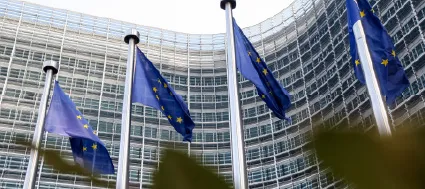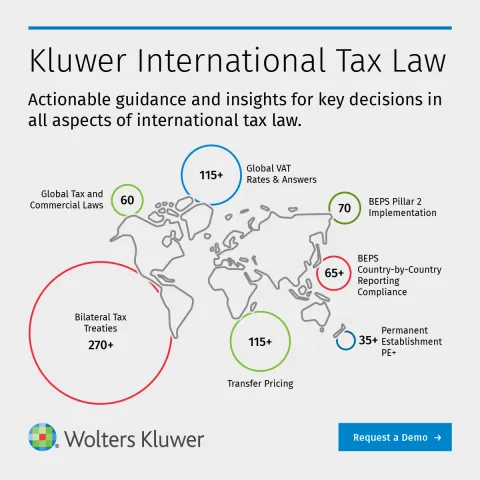The Contents of Highlights & Insights on European Taxation Issue 9, 2025
October 1, 2025
Highlights & Insights on European Taxation
Please find below a selection of articles published this month (September 2025) in Highlights & Insights on European Taxation, plus one freely accessible article.
Highlights & Insights on European Taxation (H&I) is a publication by Wolters Kluwer Nederland BV.
The journal offers extensive information on all recent developments in European Taxation in the area of direct taxation and state aid, VAT, customs and excises, and environmental taxes.
To subscribe to the Journal's page, please click HERE
Year 2025, no. 9
TABLE OF CONTENTS
GENERAL TOPICS
– Amending Protocol EU-Switzerland on automatic exchange of financial account information to improve international tax compliance. EDPS
(comments by the Editorial Board) (H&I 2025/274)
INDIRECT TAXATION, CASE LAW
– Konreo (C-276/24). Recipient of supply of goods that cannot deduct VAT due to participation in VAT evasion, still has obligation to pay VAT due from supplier. Court of Justice
(comments by Stefanie Geringer & Jan Neckař) (H&I 2025/279)
– Hogkullen (C-808/23). Determination of the tax base at the market level for intragroup transactions. Court of Justice
(comments by Estefania Lopez Llopis) (H&I 2025/278)
– Galerie Karsten Greve (C-433/24). Option to apply margin scheme for art dealers when art is supplied by legal person attributable to creator and supply constitutes as first market introduction. Court of Justice
(comments by Luca Sabbi) (H&I 2025/277)
– Arcomet Towercranes (C-726/23). Remuneration of intra-group services. Transfer pricing. Court of Justice
(comments by Giorgio Beretta) (H&I 2025/270)
– Modexel (C-680/23). No carry forward excess VAT after cessation economic activity. Court of Justice
(comments by Conceicao Gamito, Rita Simao Luis & Nidia Rebelo) (H&I 2025/267)
– Beach and bar management (C-733/23). Ne bis in idem. EU law precludes financial imposition after an administrative measure. Court of Justice
(comments by Edwin Thomas) (H&I 2025/257)
MISCELLANEOUS
– Citizens’ attitudes towards taxation
(comments by the Editorial Board) (H&I2025/275)
FREE ARTICLE
– Hogkullen (C-808/23). Determination of the tax base at the market level for intragroup transactions. Court of Justice
(comments by Estefania Lopez Llopis) (H&I 2025/278)
Two questions, only one answer
In essence, the judgment delivered by the Court of Justice of the European Union (hereinafter: 'CJ') in Högkullen (CJ 3 July 2025, C-808/23 Högkullen, ECLI:EU:C:2025:516) focuses on clarifying how the taxable amount of VAT should be determined in respect of intra-group services supplied by a parent company whose sole activity consists of the active management of its subsidiaries.
As a general rule, the taxable amount of VAT is well known to be ‘the consideration established between the parties and actually received by the taxable person, and not a value estimated according to objective criteria, such as the market value or a reference value determined by the tax authority’ (Högkullen, C-808/23, paragraph 21). As an exception, however, Article 80 of Council Directive 2006/112/EC of 28 November 2006 on the common system of value added tax (hereinafter: 'the VAT Directive') allows Member States to use the open market value (OMV) to calculate the taxable amount when the parties are closely linked to each other (as in this case), the recipient of the transaction does not have the right to fully deduct input VAT (as in this case), and the consideration paid is lower than the open market value. This latter concept is defined in Article 72 of the VAT Directive, which provides for two possible methods for its determination: the comparison method (first paragraph) and the cost method (second paragraph), which is only applicable where no comparable goods or services can be identified.
Regarding the first preliminary question, concerning the existence of several independent supplies or a single supply, the CJ’s response leaves little room for debate. After analysing the circumstances of the case, it was concluded that the services provided by Högkullen are separable and readily identifiable despite being provided jointly and in exchange for a single overall price. Indeed, there are no ancillary services in relation to another that could be regarded as the principal supply, nor are the services in question so interconnected as to give rise to a new, distinct supply. Therefore, it seems reasonable to hold that the OMV must be determined separately for each service. This conclusion, fully consistent with the Advocate General (AG) Kokott’s interpretation (Opinion of AG Kokott 6 March 2025, C-808/23 Högkullen, ECLI:EU:C:2025:149), aligns with previous case law of the CJ on dependent ancillary services and single complex supplies (Högkullen, C-808/23, paragraphs 26-30).
It is also unsurprising that the second prejudicial question is left unanswered, as, in the CJ’s view, it is based on a mistaken premise: ‘that, in the case of active management of its subsidiaries by a parent company, there are no comparable services freely available on the market’ (Högkullen, C-808/23, paragraph 36). Once this premise is dismissed, there is no need to examine how the second paragraph of Article 72 of the VAT Directive should be interpreted, as it is not applicable to the present case. In this way, the CJ avoids ruling on one of the most contentious aspects of the Högkullen case, particularly when analysed in light of its previous case law on holding companies.
The anti-abuse purpose of Article 80 of the VAT Directive and its connection with holding company case law.
By way of exception, Article 80 of the VAT Directive allows the use of the OMV to calculate the taxable base under certain circumstances. The rationale of this provision, according to its own wording, is to provide Member States with a safeguard mechanism ‘to prevent tax evasion or avoidance’. It is therefore from this perspective that the CJ’s judgment in Högkullen (C-808/23) must necessarily be analysed.
In my view, the key issue to be addressed is whether the CJ's response to the first preliminary question could, in practice, lead to abusive strategies or tax fraud on the part of holding groups. AG Kokott, who adopts a critical approach in her Opinion, rightly draws attention to this risk. As she apparently suggests, the CJ’s case law on holding companies itself encourages the creation of artificial structures based on the supply of services to subsidiaries in exchange for consideration, with the sole purpose of obtaining undue tax advantages (AG's Opinion in Högkullen, C-808/23, paragraph 35).
Particularly, the Högkullen judgment addresses the case of a parent company that is exclusively engaged in the active management of its subsidiaries and, in the context of this activity, supplies them with various services for consideration. According to settled EU case law, such a circumstance would be sufficient for the parent company to be regarded as a taxable person for VAT purposes.
Additionally, it would be a taxable person with the right to full deduction, as all the transactions it carries out would be subject to VAT and not exempt. This right to deduct would extend not only to costs directly and immediately linked to the services supplied but also to the company’s overheads, including the so-called shareholder costs and expenses related to future acquisitions of shares.
This conclusion has already been supported by the CJ in other important cases. For instance, in Cibo Participations (C-16/00), it was held that ‘the involvement of a holding company in the management of companies in which it has acquired a shareholding constitutes an economic activity […] where it entails carrying out transactions which are subject to VAT […], such as the supply by a holding company to its subsidiaries of administrative, financial, commercial and technical services’ (CJ 27 September 2001, C-16/00 Cibo Participations, ECLI:EU:C:2001:495, paragraph 22). Regarding the deduction of input VAT, it was added that ‘expenditure incurred by a holding company in respect of the various services which it purchased in connection with the acquisition of a shareholding in a subsidiary forms part of its general costs and therefore has, in principle, a direct and immediate link with its business as a whole’ (Cibo Participations, C-16/00, paragraph 35). In light of this reasoning, it is somewhat surprising that, in paragraph 69 of her Opinion on the Högkullen case, the AG refers to expenditure connected with a future acquisition of shareholdings as an example of costs not linked to the services supplied by the parent company, which clearly diverges from the position taken by the CJ in Cibo Participations (C-16/00) and other significant rulings (see, for example, CJ 17 October 2018, C-249/17 Ryanair Ltd, ECLI:EU:C:2018:834).
No one disputes, not even the Swedish tax authorities, Högkullen’s right to fully deduct all input VAT incurred during 2016. This right, which has effectively been exercised, is supported by the CJ's case law and therefore cannot be rejected. The problem arises because, in Högkullen’s view, the so-called shareholder costs are not directly linked to the services it supplies. Consequently, all input VAT related to these costs is deducted but not recharged to the subsidiaries, thereby creating an asymmetry between input and output transactions that threatens to undermine the principle of fiscal neutrality. Hence, the need to answer a crucial question: how should the taxable base of the services supplied by Högkullen be determined?
The CJ’s answer to the preliminary questions clearly indicates that, in this particular case, the VAT taxable amount must be determined in accordance with the first paragraph of Article 72 of the VAT Directive, which refers to the OMV of comparable services. In this regard, it is essential to consider that, as stated in paragraph 9 of the judgment, Högkullen provided its subsidiaries with a number of centralised services that it had previously purchased from third parties. In a situation such as the one at stake, therefore, not only can it be expected that market reference prices exist, but also, as the AG points out in paragraph 49 of her Opinion, ‘there is no apparent evidence to suggest that the consideration paid by the holding company should not be regarded as a comparison price’, as ‘there is a presumption that a price paid between third parties dealing at arm’s length corresponds to the market value of a service’ (AG's Opinion in Högkullen, C-808/23, paragraph 49).
Once the use of the comparison method is accepted to determine the OMV of the services supplied, it seems reasonable to expect that this OMV will ultimately be lower than the total costs incurred by Högkullen in carrying out its economic activity. The reason is clear: those total costs include not only the price paid for the acquired services that are subsequently recharged to the subsidiaries (the single element that, according to the aforementioned reasoning, would be considered in quantifying the market value) but also other expenses, such as the shareholder costs, which would be excluded from the VAT taxable amount of the supplies made, despite being taxed with a VAT that the parent company has fully deducted.
As the AG points out in her Opinion on the case, it must be admitted that ‘the mere fact that the input VAT deducted in respect of the input services exceeds the tax liability arising from the output services is not by itself […] an indication of tax evasion or avoidance’ (AG's Opinion in Högkullen, C-808/23, paragraph 54). Nor is it an indication of tax evasion or avoidance that a given transaction is carried out ‘below the usual market price’ or that ‘the supplier has not made a profit’ (AG's Opinion in Högkullen, C-808/23, paragraphs 54-55). From this perspective, I agree that ‘the risk which Article 80 of the VAT Directive seeks to combat cannot stem from the amount of the price and the tax revenue resulting therefrom’ (AG's Opinion in Högkullen, C-808/23, paragraph 55), but rather from the close connection between the supplier and the recipient of the transaction apparent in this case.
Starting from this premise, I consider it necessary to distinguish between two situations. One situation is where market conditions do not allow the taxable person to pass on all their costs to the recipient of the taxable transaction. Another, very different one, is where costs are deliberately not charged to customers with the exclusive purpose of obtaining undue tax advantages.
Focusing our attention on the parent-subsidiary relationship, it should also be noted that, from an economic and financial perspective, the holding company of a group does not need to cover all its costs through income derived from the supply of services to its subsidiaries, as it has an additional source of revenue linked to its shareholder status that enables it to cover these costs and even to make a profit, namely, the dividends it receives from such entities. This circumstance creates fertile ground for the development of abusive strategies based on the creation of holding structures, the purchase of services from third parties through the parent company, and the subsequent recharge of these services to other companies in the group (which do not have the right to fully deduct VAT) at a price lower than would otherwise have been applied.
The conclusion we finally reach is that the interplay between Article 80 of the VAT Directive, the first paragraph of Article 72, and the CJ’s case law on holding companies results in a tax advantage for the group regarded as an economic unit, as the parent company deducts all input VAT incurred in its purchases and then passes it on only partially to its subsidiaries, which have a limited right to deduct. Hence, the group as a whole ends up deducting more VAT than it would if only the transactions carried out by the group itself with third parties through its subsidiaries were considered. In other words, the group obtains a greater deduction than a sole trader or a single taxable person would. This outcome entails a clear breach of two fundamental principles: the principle of fiscal neutrality, which ‘requires that economic operators that carry out the same transactions not be treated differently for the purposes of VAT unless differentiation is objectively justified’ (see, for example, CJ 27 June 2018, C-459/17 SGI, ECLI:EU:C:2018:501, paragraph 44), and the principle of neutrality of legal form, which is rightly invoked by the AG in paragraph 34 of her Opinion.
Possible solutions.
To avoid the problem described in the previous section, I believe that two possible alternatives could be considered.
The first alternative, which aligns closely with the AG’s conclusions, would be to amend the CJ’s case law on holding companies. Such an amendment would involve recognizing that every parent company of a corporate group is a taxable person for VAT purposes, regardless of whether it supplies services to its subsidiaries for consideration. Additionally, a deduction regime would need to be established for that entity, based on the transactions carried out by the group itself with independent parties. This would mean treating the group as a single taxable person in all cases, even if the Member State concerned had not opted to introduce a grouping scheme under Article 11 of the VAT Directive.
The second alternative, based on the advanced modality of the Spanish VAT grouping scheme, would consist of introducing a mandatory rule into the VAT Directive for calculating the taxable base of all transactions that are carried out between members of the same corporate group. According to this rule, which is set out in Article 163 octies of the Spanish VAT Act (Law 37/1992), the taxable amount of such transactions would include the cost of any goods and services, whether directly or indirectly, wholly or partly, used to carry out the transaction, provided that VAT has been paid on their acquisition and is deductible. When the goods used qualify as capital goods, Article 163 octies further stipulates that the cost of those goods must be allocated within the adjustment period set out in Spanish legislation (ten years for immovable property and five years in other situations). It should be emphasised that this second provision is fully consistent with the suggestion made by the AG in her Opinion on the Högkullen case. In effect, when addressing the second question referred by the national court, which relates to the determination of the open market value of a transaction in accordance with its cost, she notes that: ‘Article 187 of the VAT Directive […] provides that input VAT deducted in respect of investment costs is not to be adjusted immediately in the event of a change in circumstances but rather over a period of a number of years. That assessment and the time periods mentioned in that provision – which the Member States can influence to some extent – may be applied by analogy in the present case’ (AG's Opinion in Högkullen, C-808/23, paragraph 72).
Experience in Spain has shown that the second alternative may prove difficult to implement in practice, as it requires identifying which goods and services are used in intra-group transactions and in what proportion, as well as their associated costs and tax burdens. However, it is essential to note that the second paragraph of Article 72 of the VAT Directive already stipulates the application of this rule when determining the open market value and no comparable goods or services can be identified. Additionally, it must be considered that, under this option, the parent company would ultimately charge VAT to its subsidiaries on all costs incurred in the course of its economic activity (including overheads and direct expenses) for which input VAT has been incurred and effectively deducted. Costs not meeting these criteria, such as those not subject to VAT or in relation to which no right to deduct arises, would be excluded from the taxable base. This mechanism, therefore, would automatically eliminate the risk of abuse and tax fraud addressed by Article 80 of the VAT Directive, which, according to the AG in Högkullen, exists only when the costs incurred by the supplying company give rise to a deductible VAT (AG's Opinion in Högkullen, C-808/23, paragraph 63).
Prof. Estefania Lopez Llopis
You may also like






